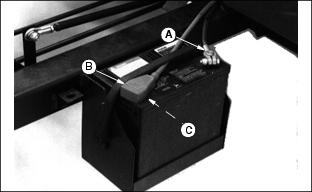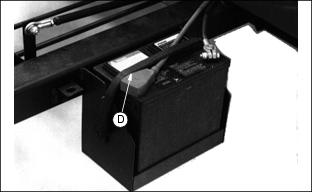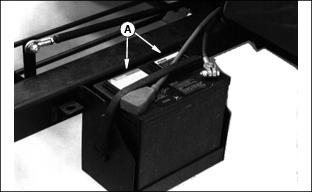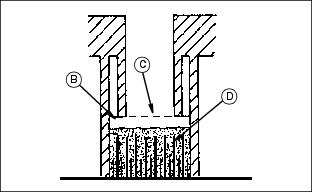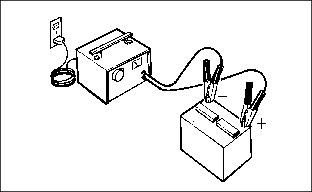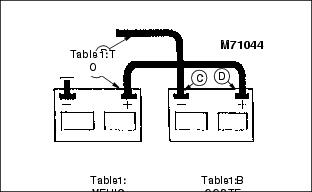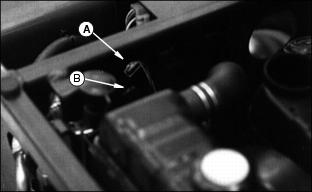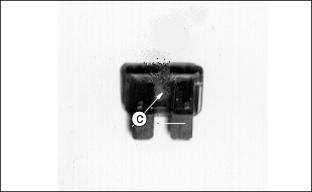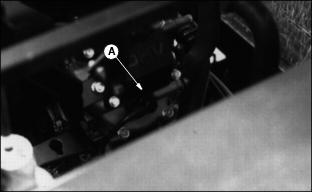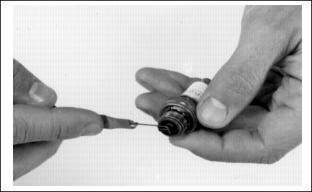Introduction
Safety
Controls
Operating
Replacement Parts
Service Machine Safely
Service Intervals
Service Engine
Service Transmission
Service Steering & Brakes
Service Electrical
Checking Battery Electrolyte Level
Cleaning And Gapping Spark Plugs
Service Miscellaneous
Troubleshooting
Storage
Assembly
Warranty
Specifications
John Deere Quality Statement
CopyrightŠ Deere & Company

Service Electrical
Cleaning Or Replacing Battery
2. Disconnect black negative (-) cable (A) from battery first.
3. Pull back positive terminal cover (B) and disconnect red
positive (+) cable (C).
4. Clean battery with a damp cloth or rag. Keep dirt out of battery cells.
5. Remove corrosion from terminals and cable clamps with a wire brush.
6. If necessary, remove battery to thoroughly clean it:
7. Clean battery, battery terminals, cable ends, battery box, and other parts with a solution of 1 part baking soda to 4 parts water. KEEP solution out of battery cells.
8. Rinse all parts with clean water and let dry.
NOTE: If you need a new battery, install a John Deere battery or a battery of equal specification. (See your John Deere distributor.)
9. Install battery and battery hold-down strap.
10. Connect red positive (+) cable to battery. Make sure connection is tight.
11. Apply petroleum jelly or silicone spray to terminal to prevent corrosion.
12. Push red positive cover over positive terminal.
13. Connect black negative (-) cable to battery. Make sure connection is tight.
14. Apply petroleum jelly or silicone spray to terminal to prevent corrosion.
Checking Battery Electrolyte Level
1. Remove battery manifold caps (A).
IMPORTANT: Avoid damage! DO NOT fill cells to the bottom of the filler neck (C). Electrolyte can overflow when battery is charged and cause damage. |
2. Electrolyte (B) should be 6 mm (1/4 in.) above plates (D).
3. Add distilled water if necessary.
Charging The Battery
Follow instructions on the battery charger or in the charger operator's manual, or use the instructions below as a guide.
ˇ Wait until the battery has warmed to room temperature. Do not charge a frozen battery.
ˇ Check the electrolyte level of each cell. (See Checking Battery Electrolyte Level in this section.)
ˇ Install the battery cap(s) on the battery.
Turn OFF and unplug the charger before you connect cables to the battery or disconnect cables from the battery.
If the battery becomes warm to touch during charging:
ˇ Stop charging the battery until it cools.
1. Remove and clean battery. (See Cleaning Or Replacing Battery in this section.)
2. Check electrolyte level. (See Checking Battery Electrolyte Level in this section.)
3. Leave cell caps on battery while you charge it.
4. Connect positive (+) charger cable to positive (+) battery terminal.
5. Connect negative (-) charger cable to negative (-) battery terminal.
7. Charge battery. See CHARGING RATES on the next page.
8. Unplug charger cord. Remove charger cables.
Charging Rates
See your battery charger or charger operator's manual for information on charging. Or read the information below to FULLY CHARGE your battery.
For a charger with a CURRENT ADJUSTMENT CONTROL:
ˇ Adjust the control to 10 amps.
ˇ Charge the battery for 6-8 hours.
For a charger with a switch for MAINTENANCE FREE, DEEP CYCLE, or NORMAL (CONVENTIONAL) setting:
ˇ Use the MAINTENANCE FREE or DEEP CYCLE setting.
For a charger with SLOW CHARGE, FAST CHARGE, or BOOST CHARGE setting:
ˇ DO NOT use the BOOST CHARGE setting.
ˇ Use the SLOW CHARGE setting:
ˇ - For a charger rated at less than 10 amps.
ˇ Use the FAST CHARGE setting:
ˇ - For a charger rated at 10 amps.
NOTE: NOTE: Your charger may have an AUTOMATIC STOP to prevent charging the battery:
ˇ When the battery is fully charged OR
ˇ When the battery is not in condition to take a charge.
Using Booster Battery
Connect positive (+) booster cable to booster battery positive (+) post (D).
Connect the other end of positive (+) booster cable to vehicle battery positive (+) post (A).
Connect negative (-) booster cable to booster battery negative (-) post (C).
Connect the other end of negative (-) booster cable to engine ground (B) away from battery.
Changing Fuses
2. Pull fuse (A) and (B) out of socket.
3. Check metal clip (C) in fuse window. Discard fuse if clip is broken.
NOTE: Make sure to replace with a fuse of proper amperage.
Push new fuse into proper socket.
Changing Indicator Bulb
NOTE: Bulb socket is removed from under panel before bulb is replaced. It may be necessary to remove front panel (A) for access to bulb sockets.
1. Reach up under dash behind indicator to remove bulb socket.
2. Remove bulb socket by turning it counterclockwise 1/4 turn.
Cleaning And Gapping Spark Plugs
2. Disconnect spark plug wires (A) from spark plugs on both sides of engine block.
3. Remove spark plugs from engine.
4. Clean spark plugs carefully with a wire brush.
ˇ Pitted or damaged electrodes.
NOTE: In Canada, replace spark plugs with resistor-type plugs only.
6. Replace spark plugs as necessary.
7. Check plug gap with a wire feeler gauge.
8. Gap must be 0.76 mm (0.030 in.).
9. To change gap, move outer electrode.

